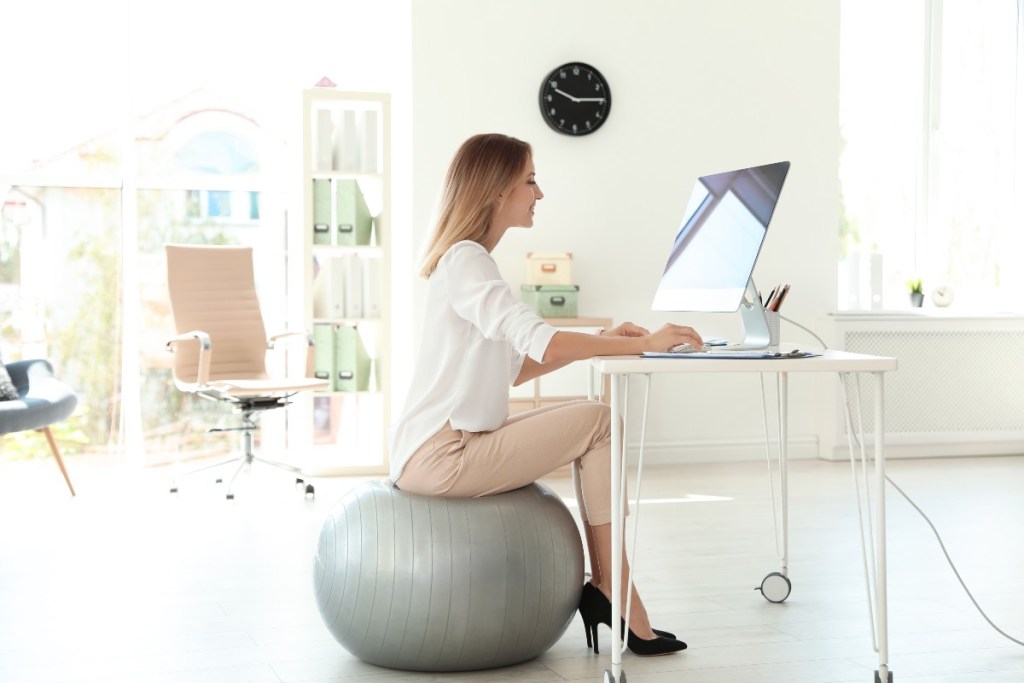Workdays are typically full of to-dos. You have projects to finish, ideas to pitch, and meetings to attend. One thing that certainly doesn’t belong on your list is developing a lousy posture.
Unfortunately, poor posture is often an occupational hazard for those with desk jobs. Though sitting seems like a harmless activity, improper alignment can cause stiffness and soreness in your neck, back, arms, and legs. These aches and pains can make it harder to do everything from exercising to just continuing to sit at our desks.
If you’re already experiencing these symptoms, it’s time to improve that posture. With a few small, simple changes, you can sit up straighter and prevent bad posture-induced chronic pain. Check out this handy guide to learn more about how to correct posture in four easy steps.

Learn how to sit properly
Let’s start by taking a look at what good posture looks like. Here are a few things to keep in mind as you plop yourself down in a chair each day.
- Make sure it’s the right chair. Choose a chair that supports your lower back, particularly one with a built-in lower back pillow or support mechanism. Ensure you can adjust your chair so your knees rest slightly lower than your hips. The desk should also be high enough that you can keep elbows by the side of your body at a 90-degree angle while typing.
- Two on the floor. Keep both feet on the floor. Crossing your legs can rotate and tilt your pelvis, harming your lower back.
- Keep screens at eye level. Yes, this includes your phone. Tech-neck is a thing, and it’s a pain caused by hunching over to peek at screens. Keep your chin high and take that tension out of your lower neck.

Get ergonomic support
If you’re struggling to sit correctly, you might need a little help. Several ergonomic supports can mitigate aches and pains and realign your body.
- Lower back pillow: If you can’t swap out your chair, consider adding a pillow behind you to better support your lower back. This supports the lumbar curve in your spine and dissuades you from hunching over.
- Footrest: Those whose feet don’t rest comfortably flat on the floor may want to invest in a footrest. Footrests can also serve as a remember to keep both feet on the floor.
- Balance ball: Ditch the chair altogether and sit on a giant balance ball. These balls encourage you to engage your core and sit up straight, keeping your body in alignment.
Move every 30 minutes
Work can get busy, but sitting at your desk all day, even with good posture, isn’t going to do your body any good. Think about it: If you did bicep curls for an hour per day every day, your arm would be pretty sore, right? You sit at your desk for about eight hours per day, in essentially the same or a similar position. That puts a similar strain on your muscles and joints.
Say goodbye to the sedentary workday and get moving for just a few minutes every day. In fact, moving every 30 minutes could help reduce the harmful effects of spending days seated at a desk.
Try desk exercises and stretches
If a lap around the office isn’t your speed, opt for desk exercises instead. Bonus: You can even do some while continuing to work.
- Calf raises: Stand. Raise your heels off the ground so you are standing on your tip-toes. Hold for two counts. Then, slowly lower legs. Repeat 10 times or more.
- Lunges: Stand with feet hip-width apart. Step one foot in front of the other until both legs are at 90-degree angles. Repeat 10 times. Switch sides.
- Chest Stretch: Stand straight. Clasp hands behind you at the base of your back. Roll shoulders down and away from your ears. Lift hands behind you until they are parallel with the ground. Repeat 10 times.
Sitting for too long at a desk can be a pain in the neck and back — literally. And hunching over and developing “tech neck” won’t allow you to feel like your best self. With a few simple tips, you can make sure your 40-hour week doesn’t give you lifelong pain. So sit up straight, keep both feet on the ground, and don’t let bad posture wreck your productivity.
BlissMark provides information regarding health, wellness, and beauty. The information within this article is not intended to be medical advice. Before starting any diet or exercise routine, consult your physician. If you don’t have a primary care physician, the United States Health & Human Services department has a free online tool that can help you locate a clinic in your area. We are not medical professionals, have not verified or vetted any programs, and in no way intend our content to be anything more than informative and inspiring.



